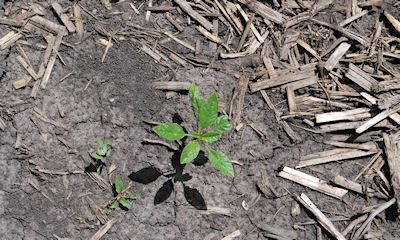August 4, 2015

Waterhemp is moving north in the Red River Valley, says Tom Peters, North Dakota State University and University of Minnesota sugarbeet specialist.
He says waterhemp has been found in fields as far north as U.S. Highway 2 – that's more than 100 miles north of where it was last year.
In the coffee shop, it is known as palmer pigweed. In university circles, it is referred to as Palmer amaranth. Whatever you want to call it, this weed is the No. 1 weed to watch. Download our free report: Palmer Amaranth: Understanding the profit siphon in your field

Waterhemp is moving north through the Red River Valley
How is it moving so far so fast? Scientists know waterhemp seed moves readily in water. Scientists also believe that geese and ducks feed on waterhemp and perhaps distribute seed as excrement along flyways. Finally, humans (us) unintentionally move seed, especially with our harvest equipment.
If you find waterhemp growing through or above the soybean canopy now, Peters recommends walking field and pulling them – if there are not too many. Otherwise mow areas where waterhemp is too dense to pull.
"It seems extreme, but extreme measure are needed for a formidable opponent like waterhemp. Farmers should set a target goal of no waterhemp plants making seed in field. No new seed entering the weed seed bank is a key step in the waterhemp management strategy for fields," he says. "We don't want waterhemp to produce seed since a large plant potentially can make 400,000 seed, seed that remains viable four to six years."
There could be field where waterhemp is still germinating and emerging in an open canopy. Peters recommends continuing spray programs since, unlike redroot pigweed, waterhemp does not go dormant when soil temperatures get high.
Peters recommends a four-point plant if you have a field with a lot of escapes and neither pulling nor mowing them is an option.
~~~PAGE_BREAK_HERE~~~
One map fields so you know what areas of the field have waterhemp or high populations of waterhemp. "Mapping might seem trivial but it will be difficult to reflect on areas of fields with heavy pressure once harvest is complete," Peters says.
Two, develop a strategy for field. A strategy might be tillage, the crop(s) planted in the field or even row spacing crops are planted at.
Three, develop a strategy for herbicides. "I recommend a soil-applied herbicide regardless of crop in fields with heavy waterhemp density. Soil applied herbicides should be followed with scouting and timely application of postemergence herbicides applied in combinations (two herbicides that are efficacious against waterhemp) and applied when weeds are small," Peters says.
Four, plan to scout for waterhemp all season long. It germinates and emerges much longer than redroot pigweed.
You will need to follow your strategy for years. Waterhemp seed remains viable for four to six years, Peters says.
You May Also Like




